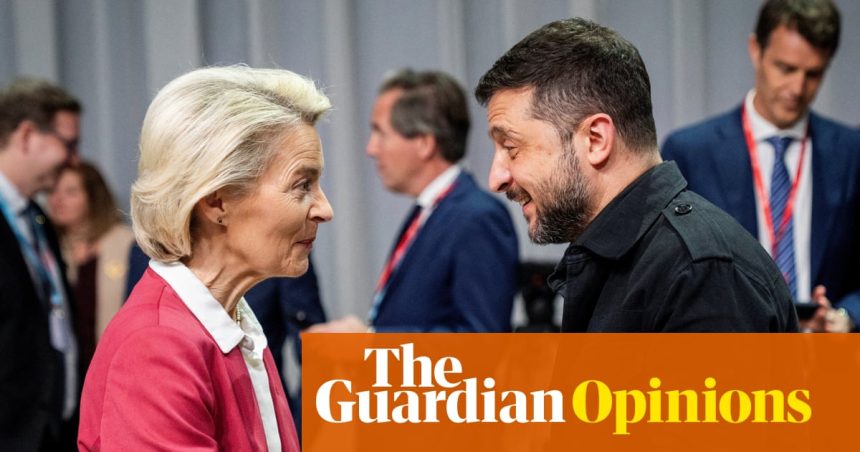The closer Russia’s hybrid war comes to European capitals, the less EU leaders seem able to agree on how to respond. That, at least, was the worrying impression left by a dissonant EU summit in Copenhagen. Summoned last week to build consensus on the top priorities for European rearmament, the meeting was an embarrassing display of the turf wars, political squabbles and hidden agendas that are plaguing attempts to build a coherent European defence. Leaders quarrelled not only about who should be in charge of Europe’s military buildup but also about how to fund Ukraine’s continued resistance against Russian aggression, and how to advance Kyiv’s bid for EU membership.
They voiced alarm at repeated breaches of their airspace by drones buzzing European airports and military bases, and Russian fighter jets violating their borders but appeared unsure how to react. Shoot them down? Escort them out? Keep calm and carry on? Or hit back by leveraging frozen Russian assets to provide a giant loan to Ukraine, taking more aggressive steps to choke off Moscow’s oil and gas exports, and giving Kyiv long-range missiles to strike deeper inside Russia? No consensus emerged in Copenhagen, but decisions need to be taken soon.
The Russian president, Vladimir Putin, must be laughing at the cacophony in the Danish capital and may well draw the conclusion that Europe is weak and divided in response to his mounting provocations. That would be dangerous for all sides.
Leaders of the biggest EU powers used the informal summit to slap down the European Commission president, Ursula von der Leyen’s, proposal to build a multilayered drone wall for eastern Europe after the spate of Russian airspace violations and incidents involving Moscow’s shadow fleet of sanctions-busting rust-bucket oil tankers.
In a paper circulated to leaders, von der Leyen proposed four European flagship defence projects: a European drone wall, an eastern flank watch surveillance network, an air defence shield and a defence space shield. She also said the EU executive would monitor member states’ progress in meeting targets to boost readiness by 2030 through a new reporting and assessment process.
The French president, Emmanuel Macron, dissed the drone wall concept, saying something “more sophisticated and more complex” was needed. The German chancellor, Friedrich Merz, slammed overregulation by Brussels and savaged the anti-drone plan behind closed doors. The Italian prime minister, Giorgia Meloni, complained that Brussels was focused exclusively on protecting eastern countries, and ignoring the southern flank. She also hinted at another objection: this should be Nato’s job, not the EU’s.
The row was about power, not drones. National leaders suspected a commission power grab behind the defence initiatives and wanted to put von der Leyen back in her box.
It’s fine for Brussels to offer member states €150bn in loans for collaborative defence procurement projects and to ease rules to allow more deficit spending for defence. But big EU governments want to keep control in their own hands, with groups of countries developing different capabilities to meet their Nato force requirements.
These turf wars have been around ever since the EU began to play a role in defence 25 years ago. They have resurfaced more acutely because defence is increasingly the new frontier of European integration.
No one can blame Brussels for pressing member states to spend their rising defence budgets more efficiently together rather than duplicating capabilities and failing to build a stronger European defence technology industrial base. That will require harmonising military requirements and buying less from the US.
after newsletter promotion
However, political leadership will remain with Europe’s main military powers, not least because the EU is constrained by having both neutral members (Austria, Ireland, Cyprus and Malta) and countries sympathetic to Russia (Hungary, Slovakia and soon perhaps the Czech Republic). Besides, the UK remains an indispensable player in European defence despite having left the EU.
The “coalition of the willing”, working under Franco-British leadership on security guarantees for Ukraine, could serve as the nucleus of Europe’s rearmament drive. But industrial rivalries among its core members risk undermining the common defence effort.
France and Germany are feuding over a future combat air system project they launched in 2017 and which Spain joined. The constellation of a sixth-generation fighter, advanced drones and a “combat cloud” was supposed to be a European alternative to dependence on the US F-35 and its successors. Dogfights between prime contractors Dassault Aviation and Airbus over design leadership and workshare have brought the project to the brink of collapse. Meanwhile, a rival global combat air programme piloted by the UK, Italy and Japan is moving ahead.
Underlying all these disputes is a lack of mutual trust among Europeans, exacerbated by uncertainty over the US commitment to European security under the Trump administration. When countries are not sure how far they can trust each other, their instinct is to fall back on national arms industries and militaries.
That is weakening Europe at a time when it needs to project strength and determination towards Russia. European leaders must stop scapegoating the commission and pull together urgently as if Europe were under attack, because it is.

Leave a Reply